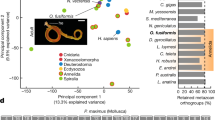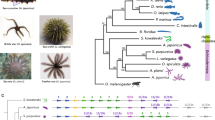Abstract
RECENT years have witnessed a series of fundamental changes in our ideas on embryology, these changes being the expression of what had formerly been a growing mistrust of some of the generalizations of the nineteenth century. Thus de Beer1, in the course of a convincing essay, set forth strong evidence to show that the theory of recapitulation cannot be accepted in its original form. Again, Oppenheimer2 has recently reviewed the results of research on the earlier stages of development, and her conclusion is that “… the doctrine of the absolute specificity of the germ-layers as enunciated in the last century must be abandoned”. So early as 1894, Garstang3 had presented evidence leading him to believe that the ancestor of the chordates could be found in an animal closely approximating to the present larval forms of echinoderms. One important consequence of Garstang's work in this direction is that it has led to the recognition of the fact that evolution can act on the earlier stages of development; the original recapitulation theory supposed that evolution worked only on adult forms, tacking on, as it were, additional phases at the end of ontogeny. The echinoderm theory has received ever-increasing attention, until now it may be regarded as the most important attempt to solve the problem of the ancestry of the chordates.
This is a preview of subscription content, access via your institution
Access options
Subscribe to this journal
Receive 51 print issues and online access
$199.00 per year
only $3.90 per issue
Buy this article
- Purchase on Springer Link
- Instant access to full article PDF
Prices may be subject to local taxes which are calculated during checkout
Similar content being viewed by others
References
de Beer, G. R., “Embryology and Evolution”, Oxford (1930).
Oppenheimer, J. M., “The Non-Specificity of the Germ-Layers”, Quart. Rev. Biol. Sci., 15, 1 (1940).
Garstang, W., “Preliminary Note on a New Theory of the Phylogeny of the Chordata”, Zool. Anz., 17 (1894).
Fell, H. B., “The Direct Development of a New Zealand Ophiuroid”, Quart. J. Micro. Sci. (in the press).
Kirk, H. B., “On the much-abbreviated Development of a Sand-star (Ophionereis schayeri?)”, Trans. N.Z. Inst., 48 (1916).
Russo, A., “Embriologia dell’ Amphiura squamata”, Atti. R. Acad. Nap., Ser. 2, 5 (1891).
Author information
Authors and Affiliations
Rights and permissions
About this article
Cite this article
FELL, H. Origin of the Vertebrate Coelom. Nature 145, 906–907 (1940). https://doi.org/10.1038/145906a0
Issue Date:
DOI: https://doi.org/10.1038/145906a0
Comments
By submitting a comment you agree to abide by our Terms and Community Guidelines. If you find something abusive or that does not comply with our terms or guidelines please flag it as inappropriate.



